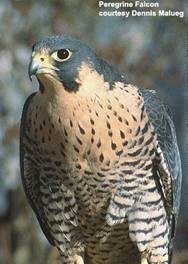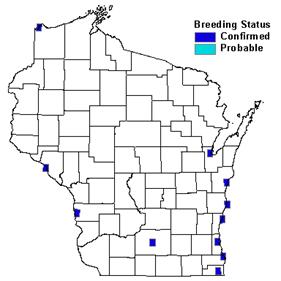

Status/Protection
- Global Rank: G4 Key to global and state ranks
- State Rank: S1S2B
- WBCI Priority: SGCN, State Endangered
Population Information
The Federal BBS information can be obtained at http://www.mbr-pwrc.usgs.gov/bbs/bbs.html by clicking on Trend Estimates and selecting the species in question. All estimates are for time period (1966-2005).
*Note: There are important deficiencies with these data. These results may be compromised by small sample size, low relative abundance on survey route, imprecise trends, and/or missing data. Caution should be used when evaluating this trend.
- Federal Breeding Bird Survey: significant decline*
- Federal Breeding Bird Survey (WI): N/A
- Federal Breeding Bird Survey (BCR 23): N/A
- Federal Breeding Bird Survey (BCR 12): N/A
- WSO Checklist Project: significant increase (1983-2007)
- Midwest Peregrine Falcon Restoration Program: 210 territorial pairs in 2006 (Redig et al. 2007)
Life History
- Breeding Range: Spotty distribution throughout North America and worldwide.
- Breeding Habitat: Bottomland Hardwood.
- Nest: Scrape on cliffside, nest platform, or other artificial structure (White et al. 2002).
- Nesting Dates: Mid-April to late May (Robbins 1991).
- Foraging: Aerial pursuit (Ehrlich et al. 1988).
- Migrant Status: Short-distance migrant, Neotropical migrant.
- Habitat use during Migration: Forested Ridge and Swale; barrier islands, seacoasts, lake edges, or mountain ranges (White et al. 2002).
- Arrival Dates: Late February to early June (Robbins 1991).
- Departure Dates: Mid-August to early December (Robbins 1991).
- Winter Range: Coastal Maine south through the U.S. (White et al. 2002).
- Winter Habitat: Extreme variability (White et al. 2002).
Habitat Selection
The Peregrine Falcon uses a wide variety of habitats and landscapes throughout its life cycle. Barrier islands, seacoasts, lake edges, and mountain ranges are used during migration (White et al. 2002). In the Midwest, the major migratory routes include the shorelines of the Great Lakes and major rivers such as the Mississippi (Gieck 1988). The Peregrine Falcon has never been a common breeder within the state but historical nest sites included rocky ledges, cliffs, bluffs, and tops of large trees (Septon 2006). Today, it commonly uses artificial structures within urban areas, such as power plant smoke stacks and skyscraper ledges (White et al. 2002). Nest sites are located in areas that will provide protection from inclement weather and mammalian predators, are often near a water source, and are 8-400 m above ground (Bent 1961, Ponton 1983, Gieck 1988, Johnsgard 1990, White et al. 2002).
Habitat Availability
The Peregrine Falcon historically nested along the steep bluffs of the upper Mississippi and Wisconsin rivers, the cliffs of Door County, and the rocky ledges along the south shore of Lake Superior (Septon 2006). Today, natural and manmade substrates along the Lake Michigan shoreline and the Mississippi River support the majority of the state’s nesting pairs, where approximately 47% of nests were located on power plant smoke stacks (Redig et al. 2007). Urban areas also provide an abundant prey base in the form of Rock Pigeons. Assuming that active nest sites are not destroyed or severely altered, habitat does not appear to be limiting Peregrine Falcons in Wisconsin.
Population Concerns
The size of the North American Peregrine Falcon population prior to the twentieth century is unknown. However, there is speculation that their decline began as early as the last quarter of the nineteenth century due to climate change (Nelson 1969) and the extinction of the Passenger Pigeon (Beebe 1969). In the 1930s and 1940s, there were approximately 500 breeding pairs of Peregrine Falcons in the eastern U.S. and approximately 1000 in the western U.S. and Mexico (USFWS 1999). Beginning in the late 1940s, organochlorine pesticide poisoning decimated the eastern population and reduced the western population by as much as 50% in some areas (Hickey 1969, White et al. 2002). The precipitous population crash was largely attributed to the pesticide DDT (DDE), which can cause either direct mortality or compromise reproductive ability (White et al. 2002). The eyries along the Wisconsin River were abandoned by 1957, those along Niagara Escarpment (Door County) by 1958, and the 14 eyries along the Mississippi River by 1964 (Berger and Mueller 1969). Berger et al. (1969) also surveyed 133 historical sites throughout the eastern U.S. in 1964 and found none to be active. The Peregrine Falcon was listed as a federally endangered species in 1970 and a Wisconsin endangered species in 1975.
The most significant factor in the recovery of the Peregrine Falcon was the restriction placed on the use of organochlorine pesticides (USFWS 1999). Wisconsin banned the use of DDT in 1971 followed by the federal government ban in 1972. Consequently, reproductive rates in surviving populations began to improve, but more intensive management was warranted in areas of complete extirpation, i.e., eastern U.S. A recovery program was instituted to reestablish Peregrine Falcons to the eastern U.S. by releasing offspring from parents of multiple subspecies (USFWS 1999). The Wisconsin Peregrine Falcon recovery program began in 1987 with the release of 14 captive-produced young peregrines in Milwaukee (Septon 1988) followed by releases in Madison, La Crosse, Racine, and Pleasant Prairie (Ausloos and Lien 1988). As of 2006, the Wisconsin reintroduction program had established 27 territorial pairs and fledged 435 young (Redig et al. 2007). Migration datasets from the eastern and western U.S. show a dramatic increase in the number of Peregrine Falcon sightings since the 1980s, further indicating a strong recovery (Mueller et al. 1988, Hoffman and Smith 2003).
Recommended Management
Protecting active nest sites in urban and natural areas should be a conservation priority and wherever applicable, nest sites should be managed to preclude vegetative succession (Gieck 1987). The continued cooperation with Lake Michigan and Mississippi River utilities and other municipal entities is critical for future installation and maintenance of nest boxes (WDNR 2005). The continuation of wetland management, protection, and restoration efforts such as the Wetland Reserve Program, Partner for Fish and Wildlife program, and North American Wetland Conservation Act will benefit this species. The protection and proper management of the Great Lakes ecosystems also is important to migrating and breeding Peregrine Falcons.
Research Needs
Continued monitoring of Peregrine Falcon distribution and abundance is needed as populations recover. Research is needed to assess changes in reproduction, age of first breeding, and survival rates relative to increased population density and saturation of nesting habitat (White et al. 2002).
Information Sources
- Chequamegon National Forest Bird Survey (NRRI) species account: http://www.nrri.umn.edu/mnbirds/accounts/PEFAa2.htm
- Cornell Lab of Ornithology species account: http://www.birds.cornell.edu/AllAboutBirds/BirdGuide/Peregrine_Falcon.html
- Midwest Peregrine Society: http://midwestperegrine.org/
- North American Breeding Bird Survey: http://www.mbr-pwrc.usgs.gov/bbs/bbs.html
- WDNR fact sheet: http://www.dnr.state.wi.us/org/land/er/factsheets/birds/falcon.htm
- We Energies species account: http://www.we-energies.com/environment/peregrine_falcon.htm
- Wisconsin Breeding Bird Atlas: http://www.uwgb.edu/birds/wbba/
References
- Ausloos, B. J. and R. Lien. The 1988 peregrine falcon release at Madison, Wisconsin. The Passenger Pigeon 50:305-309.
- Beebe, F.L. 1969. Passenger Pigeon and Peregrine ecology. Pages 399-402 in Peregrine Falcon populations: their biology and decline (J.J. Hickey, ed.). University of Wisconsin Press, Madison.
- Berger, D.D. and H.C. Mueller. 1969. Nesting Peregrine Falcons in Wisconsin and adjacent areas. Pages 115-122 in Peregrine Falcon populations: their biology and decline (J.J. Hickey, ed.). University of Wisconsin Press, Madison.
- Berger, D.D., C.R. Sindelar, Jr., and K.E. Gamble. 1969. The status of breeding Peregrines in the eastern United States. Pages 165-173 in Peregrine Falcon populations: their biology and decline (J.J. Hickey, ed.). University of Wisconsin Press, Madison.
- Ehrlich, P.R., D.S. Dobkin, and D. Wheye. 1988. The birders handbook: a field guide to the natural history of North American birds. Simon & Schuster, Inc. New York.
- Gieck, C.M 1987. Wisconsin’s Peregrine Falcon Recovery Plan. Wisconsin Department of Natural Resource Report No. 27. Bureau of Endangered Resources, Madison, WI.
- Gieck, C.M. 1988. Wisconsin’s Peregrine Falcon Recovery Plan. The Passenger Pigeon 50:9-13.
- Hickey, J.J. 1969. Peregrine Falcon populations: their biology and decline. University of Wisconsin Press, Madison. 569pp.
- Hoffman, S.W. and J.P. Smith. 2003. Population trends of migratory raptors in western North America, 1977-2001. Condor 105(3): 397-419.
- Nelson, M.W. 1969. The status of the Peregrine Falcon in the Northwest. Pages 61-72 in Peregrine Falcon populations: their biology and decline (J.J. Hickey, ed.). University of Wisconsin Press, Madison, WI.
- Johnsgard, P.A. 1990. Hawks, eagles, & falcons of North America: biology and natural history. Smithsonian Institution Press.
- Ponton, D.A. 1983. Nest site selection by Peregrine Falcons. Raptor Research 17:27-28.
- Redig, P.T., J.S. Castrale, and J.A. Goggin. 2007. Midwest Peregrine Falcon restoration 2006 report. http://midwestperegrine.org (3 May 2007)
- Robbins, S.D., Jr. 1991. Wisconsin birdlife: population and distribution past and present. Madison, WI: Univ. Wisconsin Press.
- Septon, G. 1988. Wisconsin's peregrine falcon recovery program - the first year. The Passenger Pigeon 50:165-176.
- Septon, G. 2006. Peregrine Falcon. In Atlas of the Breeding Birds of Wisconsin (N.J. Cutright, B.R Harriman, and R.W Howe, eds.). The Wisconsin Society of Ornithology, Inc. 602 pp.
- White, C.M., N.J. Clum, T.J. Cade, and W.G. Hunt. 2002. Peregrine Falcon, (Falco peregrinus). In The Birds of North America, No. 660 (A. Poole and F. Gill, eds.). The Birds of North America, Inc., Philadelphia, PA.
- Wisconsin Department of Natural Resources (WDNR). 2005. Wisconsin’s Strategy for Wildlife Species of Greatest Conservation Need. Madison, WI.
- U.S. Fish and Wildlife Service (USFWS). 1999. Final Rule To Remove the American Peregrine Falcon From the Federal List of Endangered and Threatened Wildlife, and To Remove the Similarity of Appearance Provision for Free-Flying Peregrines in the Conterminous United States. Federal Register Vol. 64, No. 164. http://www.fws.gov/endangered/federalregister/1999/f990825.pdf (4 April 2007).
Contact Information
- Compiler: Dan Haskell, danhaskell@hotmail.com
- Editor: Kim Kreitinger, K.Kreitinger@gmail.com
